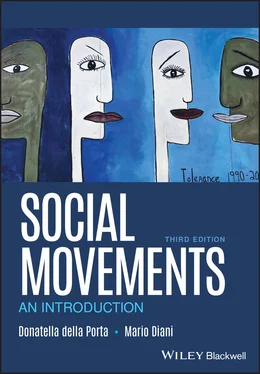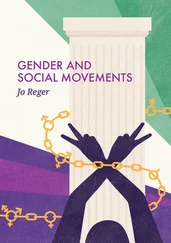Reasons for this attitude are to be found in the historically ambiguous positioning of the middle classes between the industrial bourgeoisie and the working class. Indeed, the petite bourgeoisie came to focus on symbolic production and on the defense of its own social status as a result of its uncertain place in the class system. For similar reasons, they may have felt the need to differentiate themselves from the principal social groups, and particularly from those – the industrial proletariat, throughout the twentieth century – that most closely threatened their prestige (Turner 1994; Calhoun 1993; Eder 1993, 1995). At the same time, there are reasons to argue that substantial differences separate many recent examples of lifestyle politics from the traditional version of status politics. As Featherstone (1987) noted, reference to values and lifestyles does not necessarily characterize distinctive groups with specific identities and long‐established structures. Actors involved in collective action may actually share little, apart from the common reference to a given set of values and preferences.
The relationship between new middle class and working class is not any clearer, nor has it been the subject of massive in‐depth investigation. In the case of the Netherlands study by Kriesi, it seems, for example, that even belonging to the working class could facilitate mobilization in new movements, particularly as far as younger people are concerned. Thus, there would appear to be at least a partial convergence in the new movements of those social groups which were already particularly active in “historical” opposition movements: there is a certain continuity, in other words, between “old” and “new” forms of class opposition. Also in the global justice movement, a heterogeneous social base has been highlighted as an innovative feature or an enhancement by comparison to movements of the past (Andretta et al. 2003).
In sum, there is no evidence that the material and redistributive dimension has lost all significance in conflicts in which contemporary, nonworking‐class movements are protagonists. For example, mobilizations for the development of collective services in urban areas and for urban renewal have certainly been determined by powerful concerns with collective and nonmaterial goods, such as those associated with the quality of life. However, they have also focused on the redistribution of material resources, placing the social groups most penalized by transformations in industrial activity and by processes of urban renewal in opposition to economic groups that were the protagonists and promoters of these processes (Castells 1977). These struggles have often seen the emergence of new alliances between working‐class and community groups (Brecher and Costello 1990). Furthermore, forms of collective action have emerged based on conditions of particular unease, concerned, for example, with the struggle against “new poverties.” Movements and mobilizations of homeless people have developed (Cress and Snow 1996); initiatives supporting the unemployed and marginal groups have sprung up everywhere, often in close collaboration with the voluntary sector (Bagguley 1991). In all these cases, the conflict has been concerned, once again, not only with a general notion of the quality of life, but with the allocation of material rewards among different social groups. Attention to social justice and material conditions (such as poverty) has become – as often mentioned – central in the recent wave of protest against neoliberal globalization.
Research on labor movements has also focused for long on its weakening, at least at the core of the capitalist world (see also Chapter 8). If the decline of strike activities could be interpreted as a sign of institutionalization of the industrial relations and depoliticization of the industrial conflicts, especially since the 1990s, the decline in union membership has been quoted as an indicator of an unavoidable crisis of the labor movement. Also in the service sector, a fragmented social base is hard to organize, especially with the growing flexibilization of the labor market and the connected increasing insecurity. And the more and more numerous unemployed and migrants were also difficult to mobilize.
At the beginning of the new millennium, however, conflict on labor issues again seems to be on the rise, although in new forms of anti‐austerity protests, as workers have organized in the South, where unions often increased their membership (Norris 2002, pp. 173 ff.) and grassroots networks linked workers transnationally (Moody 1997). New grassroots unions emerged (see below), and traditional unions started to invest more on the mobilization of the workers – for instance, the AFL‐CIO started to invest as much as 30% of their budget in organizing (as opposed to the usual 5%) (Fantasia and Stepan‐Norris 2004, p. 570). While labor demobilized in the private sector, in the public sector workers voiced their opposition to neoliberal reforms that cut social services (Eckstein 2001). As Piven and Cloward (2000) noticed, in the United States there has been a return to old forms of secondary action such as community boycotts, sympathy strikes, and general strikes. In France (but also in Italy and Spain) the turn of the millennium has been characterized by general strikes against pension reform, privatization of public services, cuts in public health and education. In these actions, the trade unions were joined by various movements, bridging labor issues with global justice, defense of the environment, peace, and gender equality. The claims voiced during anti‐austerity protests were oriented at the defense of those rights, which had developed in the 1960s and 1970s in the first world with liberal democracies, but also in the Third World with the developmental states, or in the second world with the really existing socialism – rights to housing, health, education, job (della Porta 2017a).
The spread of a frame of global injustice has indeed been perceived as another recent tendency in the labor movement. The NAFTA free‐trade agreements produced increasing transnational campaigns of Canadian, United States, and Mexican workers (Ayres 1998; Evans 2000). The dockers of Seattle, who had already taken part in a transnational strikes started by the dockers in Liverpool (Moody 1997), supported the protest against the WTO, extending their solidarity from the local to the international level (Levi and Olson 2000). In these waves of mobilization, the labor movement met other movements – environmentalist, feminist, urban, etc. (della Porta, Andretta et al. 2006). Moreover, increasing inequalities stimulated the rise of solidarity movements with marginal groups in the North (Giugni and Passy 2001), as well as protest by marginal groups themselves (Kousis and Tilly 2004).
In political economy, the analysis of the neoliberal financial crisis in the Great Recession brought about a revisitation of Karl Polanyi’s double movement, which singles out a shift, in capitalist development, between social protection and free market, through the action of movements and counter‐movements. Polanyi’s work has been in fact referred to in order to stress similarities or differences between the first great transformation he studied and what we can call the second great transformation. Polanyi’s analysis focuses attention to some specific forms that the counter‐movement, as the mobilization of those who feel betrayed by changes like those produced in neoliberalism, can be expected to take. Conceiving countermovements as a reactive move, he points in fact at the ways in which these mobilizations develop as defensive and backward looking. In this perspective, he looks at the first wave of liberalism during which protections for the poor, what E.P. Thompson (1971) calls “the moral economy of bread,” were taken away and this produced a rebellion not only against poverty but also against a betrayal of esteblished rights.
Читать дальше












